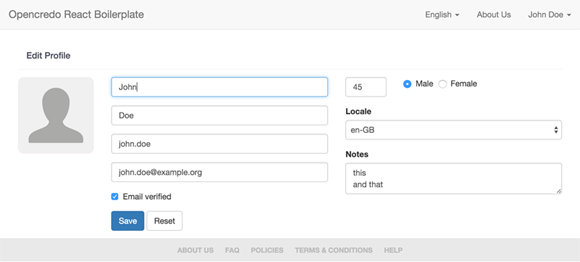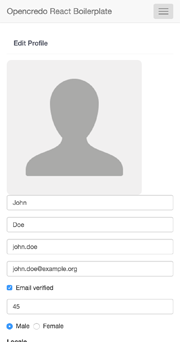React/Redux boilerplate

In this post, I'll be sharing some React/Redux boilerplate code that Vince Martinez and I have been developing recently. It's primarily aimed at developers who are familiar with the React ecosystem, so if you are new to React and/or Redux, you might like to have a look at Getting Started with React and Getting Started with Redux.
In a previous post, Facebook’s React, and the Signal:Noise Ratio, I looked at where React fits in amongst its rivals.
Firstly: why use Redux?
Many developers who have had some experience using React over the last year or two will most likely have been using one of the libraries that implements the Flux pattern – so why use something different?Dan Abramov, author of Redux, provides a very useful set of reasons for using Redux. TL;DR:
- Reducer composition: reuse functionality across stores
- Server rendering: simplifies enabling of server rendering
- Developer experience: makes it possible to change reducer code on the fly or even "change the past" by crossing out actions, and see the state being recalculated
- Ecosystem: Redux has a rich and fast-growing ecosystem
- Simplicity: Redux preserves all the benefits of Flux (recording and replaying of actions, unidirectional data flow, dependent mutations) and adds new benefits (easy undo-redo, hot reloading)
What's covered in this codebase?
We have tried to anticipate the requirements of developing a typical React app, while avoiding producing a bloated codebase. Here's a quick look at the home page: src="http://opencredo.com/wp-content/uploads/2016/03/rrb-home-not-logged-in-en_800w-min.png" alt="" />
Routing
We are using react-router as the routing library, along with react-router-redux to keep react-router and redux in sync. These allow us to exploit redux-devtools (more details below).
Development Tools
Development tools included:
redux-devtools– a live-editing time travel environment for Reduxwebpack, configured with:webpack-dev-middlewareandwebpack-hot-middlewarereact-transform-hmrandbabel-preset-react-hmre- CSS Modules, which provide auto-namespaced CSS styling, accessible from Javascript
.eslintrcpre-loader- production and development builds based on
NODE_ENV
It's also definitely worth watching Dan Abramov's React Europe 2015 talk on Hot Reloading with Time Travel.
Language
We have included the use of some recent advances in Javascript development:
- Flow – strong typing for Javascript (!)
- Babel, allowing ES2015 (aka ES6) development, and beyond – exciting new JS standards
So we can now write code like this simplified version of ProfileEditPage.js:
import React, { PropTypes, Component, Element } from 'react';
import { FormattedMessage } from 'react-intl';
import { User } from 'declarations/app';
import ProfileEditForm from 'containers/ProfileEditForm/ProfileEditForm';
import { updateUser } from 'redux/modules/user/user-actions';
import { autobind } from 'core-decorators';
import { connect } from 'react-redux';
import { messages } from './ProfileEditPage.i18n';
export class ProfileEditPage extends Component {
static propTypes = {
dispatch: PropTypes.func.isRequired,
user: PropTypes.object,
};
@autobind
handleUpdate(user: User) {
this.props.dispatch(updateUser(user));
}
render(): Element {
return ();
}
}
const mapStateToProps = (state) => ({ user: state.user, });
export default connect(mapStateToProps)(ProfileEditPage);
There is also a set of ESLint code-styling rules based on the AirBnB rules.
Design
It can be difficult to choose which design library to use, but it would appear that Twitter's Bootstrap currently has a broad uptake, so the project uses the react-bootstrap Bootstrap components for page layout, menus and a form; it is also built responsively:


Internationalisation
We are assuming that making a website available in more than one language is very often a requirement of a modern website, so all content has been rendered in English and Spanish using react-intl.
Build
As well as a development build incorporating hot module reloading and live-editing time travel, there is a sample production build:
$ npm run start # development build; point browser at http://localhost:3000/
$ npm run build # production build
Simulated Login
Selecting the right-most menu item simulates a user login; implementation of actual login is left to the developer.
Restricted Pages
Once you have logged in, a menu option for another page is available, along with a link to log out:

Check src/routes.js for examples of how to restrict certain routes to only be available when the user is logged in.
Forms
Development of HTML forms for Redux requires a rethink in terms of approach to development. We have used redux-form for form integration with Redux, and redux-form-validation for validation:

Containers vs Components
A naming convention seems to be emerging in the React community that allows us to distinguish between a stateless reusable component ("component"), and one that is dependent on state ("container" or "container component"). To this end, the directory hierarchy is separated into components and containers directories.As an observation, an iteration pattern while developing often goes like this:
- build a component to accomplish a piece of functionality
- realise that it is stateful, and could be split
- divide it into two: a thin container that handles state (fetching data, for example), which is wrapped around, and provides data to, a stateless component
Michael Chan writes more about it in his Container Components post.
Unit Testing
Some simple unit tests have been included that demonstrate unit testing with React and Redux. These are *.spec.js files, and reside in the same directory as the code they are testing.
Conclusion
We've had a lot of fun putting this codebase together. It's available on github here: https://github.com/opencredo/opencredo-react-boilerplatePlease feel free to comment, fork the project, and contribute!
Further reading
Starting off:
- React home
- Redux home
- Getting started with React
- Getting started with Redux
- Three Principles of Redux
Digging deeper:
- The Evolution of Flux Frameworks provides a more in-depth understanding of how Flux (and Flux-like) frameworks have evolved
- Container Components – Michael Chan describes a development pattern to separate stateful from stateless components
- Dan Abramov's React Europe 2015 talk on Hot Reloading with Time Travel
This blog is written exclusively by the OpenCredo team. We do not accept external contributions.
Related articles
Stay up to date with our latest blogs posts.
Looking for a hands-on software delivery partner?
Book in a quick 20 minute chat with our consultants to explore your specific project and objectives.






%20(28).png)

%20(2).png)
